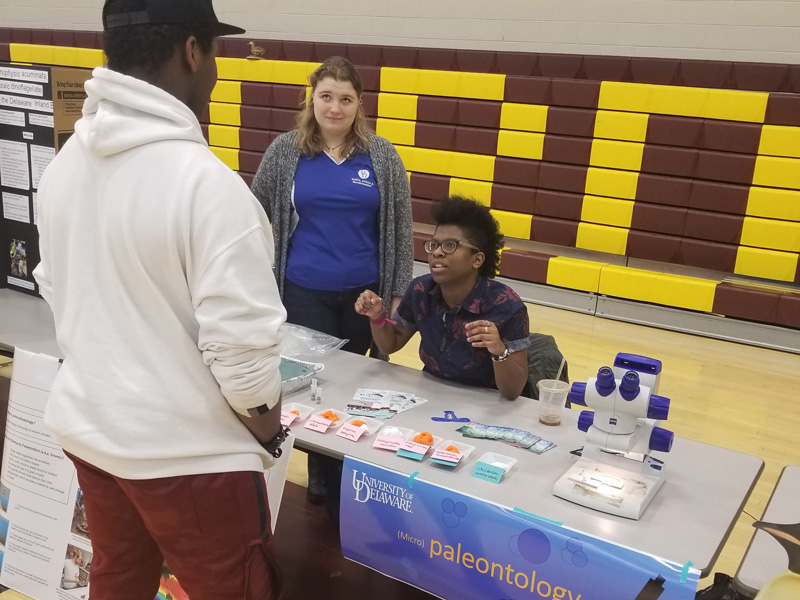


Milford Science Night
Photo by courtesy of Katherine Hudson February 15, 2019
UD students discuss marine science with 300 potential future scientists
University of Delaware graduate student Katherine Hudson remembers participating in a hands-on scientific activity looking at neutrally buoyant plankton when she was growing up. So when she and a few fellow Blue Hens were asked to help with Milford Central Academy’s Science Night, she was hoping to leave a similarly lasting impression on the 300 potential future scientists in attendance.
Hudson, a doctoral level student in UD’s College of Earth, Ocean and Environment, and peers in her research group from the Robotics Discovery Lab study animals in the ocean using autonomous underwater vehicles, which they call AUVs or, informally, their robots.
“We wanted the activity to show what we do every day to work with our robots,” said Hudson. “We make sure that they’re not too heavy so they can’t come back up to the surface but they’re not super light so they can also get down to the bottom of the ocean where we can collect data.”
The group designed an interactive activity for Science Night to illustrate how they prepare the AUVs. The UD students had the younger participants fill test tubes with lids on them with little aquarium rocks to try to get them to be neutrally buoyant in a 10-gallon tank of water.
Hudson said that the object was to make the tubes weighted “so they weren’t floating at the top and they weren’t sinking to the bottom. We tried to get them to hover right in the middle.”
In addition to teaching the students about the importance of weighting a robot for underwater exploration, Hudson was also hoping to get them interested in robots in general, exposing them to how robots are a vital part of underwater discovery.
Besides being involved in the College’s annual Coast Day programming, Hudson said that this was one of the first outreach opportunities she had and that she enjoyed working with the students.
Other UD students in attendance had an interactive activity involving microscopes highlighting research being done on algae blooms and a shark selfie station, which was a big hit with the students.
To help aid the UD students in their set up, Christopher Petrone, director of the Delaware Sea Grant Marine Advisory Service, offered instruction and provided supplies for the presentation. He supported Hudson’s idea and provided all the materials she needed, including some she hadn’t thought about, like towels to handle the inevitable water being splashed around.
Petrone said that he was happy to help the students and that Delaware Sea Grant strives to provide the students with these sorts of outreach experiences.
“It’s professional development for the students,” said Petrone. “They learn how to communicate their science quickly and effectively, and in these kinds of outreach events, you’re talking to a range of people from 4-year-olds to 80-year-olds so if they can do that in a short amount of time with high numbers of people, the more they do it, the better they’re going to get at it.”
From the feedback he received from the event, Petrone said that the students “knocked it out of the park.”
Jacquelyn Mullikin-Powers, who has been teaching sixth grade science in the Milford School District for 10 years, serves as the science fair coordinator and started the event five years ago. She has seen it blossom from the initial year with 15-20 students in attendance to this year’s event where around 300 students showed up to witness science projects from eight different exhibitors.
The purpose of the night was to get the entire community interested and engaged in science, and the event saw students from elementary age through high school learning about the careers and science opportunities in the area.
“This is the first year we have had graduate students from the University of Delaware. They were a great addition to our fair and we hope they continue to support our science night in the future,” said Mullikin-Powers. “We had a lot of ‘Wows’ and ‘Cools’ coming from students leaving the UD booth.”
Contact Us
Have a UDaily story idea?
Contact us at ocm@udel.edu
Members of the press
Contact us at 302-831-NEWS or visit the Media Relations website

